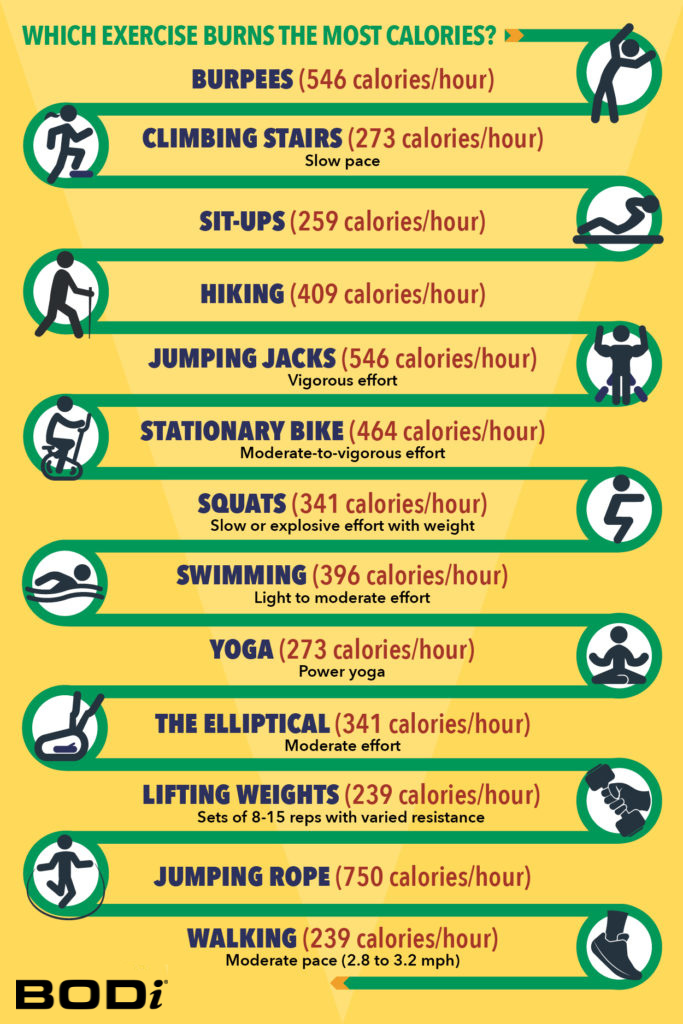Dropping fats relies on making a caloric deficit, which suggests nailing at the very least one (and ideally each) of two eventualities: consuming fewer energy than wanted to keep your present weight and burning extra energy than you eat.
That final half might be tough. Determining the variety of energy burned by train is not any small process, as there are various elements that affect that whole (e.g., weight, intercourse, age, genes, train depth). What’s extra, analysis suggests we could overestimate what number of energy we burn in a single exercise by as a lot as 4 occasions the precise quantity!
However relaxation assured, it may be accomplished. Right here, we assist minimize by the confusion. Take into account this your primer on energy burned throughout train.
2 Largest Elements in Energy Burned: Period and Depth

On the subject of caloric burn from train, length and depth are the 2 key elements that decide your closing tally.
“Of the 2, depth is a very powerful, as a result of it influences how lengthy your metabolism stays elevated when you cease figuring out,” says Trevor Thieme, C.S.C.S.
You may burn extra energy throughout an hour-long, steady-state cardio session than throughout a fast high-intensity interval coaching (HIIT) session. However that HIIT exercise will preserve your metabolism elevated lengthy after you’re accomplished exercising as your physique recovers.
This “afterburn” impact is called extra post-exercise oxygen consumption (EPOC). The longer and extra intense your exercise is, the longer and extra intense your restoration will probably be — and the extra fats you’ll in the end burn. Why? As a result of fats is what your physique makes use of to gasoline your restoration.
Calculating the precise variety of energy burned by way of EPOC might be troublesome, however in line with a research printed within the Worldwide Journal of Sport Diet and Train Metabolism, individuals who spent simply two minutes sprint-cycling burned sufficient energy within the 24 hours afterward to equal half an hour of steady-state biking.
Does weight have an effect on what number of energy you burn?
As a normal rule, the extra you weigh, the extra energy you’ll burn throughout train — or another time. “That’s merely a perform of the vitality required to maneuver your physique,” says Thieme.
That mentioned, your muscle-to-fat ratio may also decide what number of energy you’ll burn every day: “A lean, muscular 180-pound man will burn extra energy than an obese 180-pound man throughout the identical exercise just because the muscular man has extra ‘metabolically lively’ tissue,” Thieme says.
Does peak have an effect on what number of energy you burn?
Peak can have an effect on the variety of energy burned by train, however solely as a result of peak influences weight.
“Should you’re tall, you’re doubtless going to weigh extra [than someone who’s shorter],” says Tim Church, M.D., M.P.H., Ph.D., chief medical officer at Wondr Well being. Nevertheless, if you happen to weigh lower than somebody who’s shorter than you, your caloric burn could find yourself being decrease.
How Do You Calculate Energy Burned?

To determine what number of energy you burn from train, look to a technique generally utilized by train scientists to estimate vitality expenditure: metabolic equivalents.
What’s a metabolic equal (MET)?
A metabolic equal, or MET, is a measure of the quantity of oxygen you eat throughout bodily exercise, expressed in energy. METs are calculated by multiplying 3.5 milliliters of oxygen per kilogram of physique weight by the variety of minutes of exercise. To make use of a real-life instance, a 70-kg (154-lb.) individual will burn roughly 1.5 energy per minute whereas sitting in a chair.
What are energy?
We all know energy are central to weight misplaced and gained, however few of us can clarify what a calorie is.
A calorie — or Calorie, with a capital “C” — can be a kilocalorie, which suggests it’s composed of 1,000 energy. One Calorie can warmth 1 kilogram of water by 1 diploma Celsius.
Your physique makes use of the vitamins (e.g., macronutrients, micronutrients, and phytonutrients) within the Energy you eat to gasoline bodily exercise, digest meals, preserve your mind sharp, and far more.
The truth is, roughly 60 to 75 % of the energy you want per day get used as much as preserve your physique performing at relaxation. This is called your basal metabolic charge (BMR), and it varies from one individual to a different. Key elements that decide BMR embrace age, physique mass, intercourse, genetics, and organ weight. There are a number of on-line calculators that may give you an estimated BMR.
Energy Burned Throughout Completely different Sorts of Train
Fortunately, you don’t must be a scientist or mathematician to determine the variety of energy burned throughout your exercise.
The Compendium of Bodily Actions supplies MET values for a variety of actions, whereas Cornell College provides an on-line calculator the place you possibly can enter your weight, MET worth to your exercise (from the Compendium), and time to simply calculate the variety of energy you possibly can count on to burn.
We’ve used each assets to offer you estimates for the variety of energy a 150-pound individual can burn performing quite a lot of bodily actions.
1. Strolling (239 energy/hour)

Stroll at a average tempo (2.8 to three.2 mph) on a stage floor and also you’ll rack up at the very least 3.5 METs. Decide up the tempo to a brisk 3.5 mph, nonetheless, and also you’ll nab 4.3 METs, which works out to 293 energy/hour.
2. Leaping rope (750 energy/hour)

At 11.0 METs, leaping rope is corresponding to operating at a tempo of seven mph (that’s 8.5 minutes per mile). Plus, leaping actions have been proven to promote stronger bones.
3. Lifting weights (239 energy/hour)

Construct muscle mass and strengthen your bones with some good old school resistance coaching and also you’ll rack up 3.5 METs. And as you’ve already discovered, including muscle to your body means you’ll burn extra energy every day.
4. Elliptical (341 energy/hour)

Hop on the joint-friendly elliptical and pedal away at a average effort to get 5.0 METs.
5. Yoga (273 energy/hour)

There are a number of yoga types, and every provides its personal stage of depth. Energy yoga, one of many extra intense variations of this historic type of meditation, gives you 4.0 METs. Hatha yoga, which is often slower and gentler, provides solely 2.5 METs (171 energy/hour).
6. Swimming (396 energy/hour)

Swimming laps at a light-weight or average effort gives you a low-impact exercise that gives 5.8 METs. Bump up the depth to a vigorous effort, nonetheless, and also you’ll get 9.8 METs (668 energy/hour).
7. Squats (341 energy/hour)

The squat is a multi-joint train that recruits a number of massive muscle teams, together with the glutes and quadriceps. Do them and also you’ll reap 5.0 METs.
8. Stationary bike (464 energy/hour)

Biking at moderate-to-vigorous effort just isn’t solely simpler in your joints than different types of cardio train (specifically, operating), however it’ll additionally internet you 6.8 METs.
9.Leaping jacks (546 energy/hour)

Leaping jacks are thought of a vigorous type of calisthenics, which is a class of train that includes body weight actions. They’re additionally value 8.0 METs.
10. Climbing (409 energy/hour)

Spending outing in nature will internet you roughly 6.0 METs, which is able to solely enhance if you happen to add weight (like a vest) or climb hilly terrain.
11. Sit-ups (259 energy/hour)

Average-effort calisthenics like old-school sit-ups clock in at 3.8 METs.
12. Climbing stairs (273 energy/hour)

Whether or not you’re on a StairMaster or climbing the steps at work, you’ll rating 4.0 METs if you happen to climb at a sluggish, straightforward tempo. However if you happen to decide it as much as a quick tempo, you’ll get 8.8 METs (600 energy/hour).
13. Burpees (546 energy/hour)

At 8.0 METs, burpees are a full-body, high-intensity calisthenic train. The truth is, a 2014 research discovered that performing burpees provides cardiovascular advantages just like doing dash intervals on a motorbike.


